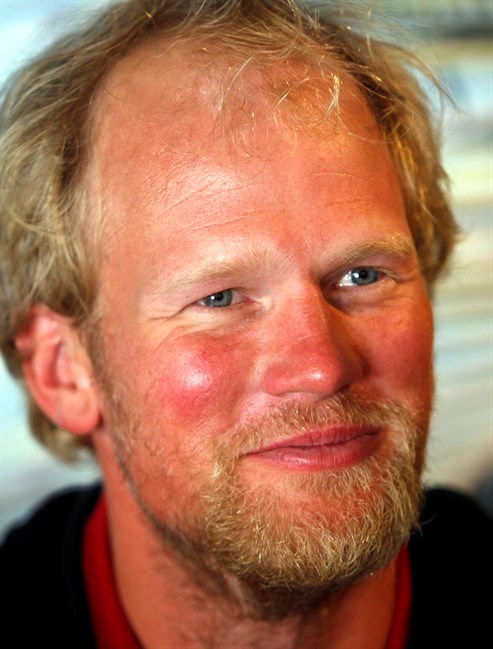Victoria rower Adam Kreek and his mate Patrick Fleming were changing shifts on the research vessel they were rowing across the Atlantic when a rogue wave crashed over the stern, flooding their cabin.
It was a shocking moment, just before 4 p.m. on Saturday, 640 kilometres north of Puerto Rico.
“I was in the cabin with Patrick as it was filling up rapidly with water, literally my worst nightmare,” Kreek said in a telephone interview Monday from a Puerto Rico hotel suite.
“You definitely don’t want to die,” he said. “And then the adrenalin fires and floods your body and all of a sudden you stop being afraid [for] your life and start acting to save your life.”
Kreek said he pushed Fleming out the hatch of the flooded cabin, then popped up to an air bubble at the top of the cabin for a second to compose himself before swimming out towards the light.
When he emerged, all three crewmates — Markus Pukonen of Tofino, and Fleming and Jordan Hanssen, both of Seattle — were already in the water, unharmed.
Kreek, a 2008 Olympic gold medalist, is now seeking a flight home, despite the fact his passport is still at sea with boat, the James Robert Hanssen, sponsored by the Canadian Wildlife Federation.
The capsizing was a “stroke of bad luck,” Kreek said. “Five minutes earlier, we would be fine. Five minutes later, we would have been fine. That’s life and that’s the ocean, too.”
Though tired, Kreek described himself as in good spirits. “Everyone is quite happy to be on land and to be safe.”
For Kreek, who won a gold medal for Canada in 2008, the voyage is over after 73 days at sea, covering most of the 6,700-kilometre journey from Senegal to Florida. After leaving Jan. 23, the crew had been expected to reach Miami on April 20.
His wife Rebecca — seven months pregnant and on bed rest — was panic-stricken by the news of the capsizing, he said. Their two-year-old son is too young to process the near-miss. “All he knows is that daddy’s safe and he’s coming home and that’s what I think is most important to me and my wife, too,” Kreek said. “I just have to be home there with my family.”
For Pukonen, the Canadian Wildlife Federation Africa to Americas Expedition was no failure, despite the capsizing. “It sucks that our boat is floating upside down in the Atlantic, but on the scientific side, it was a big success.”
Using research equipment, the four endurance rowers collected daily readings on water temperature, salinity, alkalinity and ocean currents. They also shared their observations on marine life and rowing conditions online through blogs, photography and videography.
Most of the data was sent to land as they went, but a lot of valuable equipment is still out in the Atlantic, along with about 100 hours of film footage lost when the boat overturned.
“That was my baby on board,” said Pukonen, a filmmaker. “To leave it behind was hard, but it wasn’t worth risking my life,”he said. “We will do our best to retrieve it, but if that’s not possible, it will be one with the sea.”
Pukonen says they’re lucky to be alive.
The U.S. Coast Guard showed up about five hours after the crew’s distress signal was sent. The time passed quickly, but it was an “incredible” sight to see the plane come over, Kreek said.
He said the crew hopes to get back the 8.8-metre vessel, worth about $150,000, with $40,000 more in research equipment onboard.
The crossing would have been a world first, he said, since no one has ever been able to row from Africa to North America. But Kreek said the crew didn’t do it for the record. “Our primary goal was to reach out to youth and the general public and talk about how incredible nature is and how incredible the environment is. And to encourage people to be curious and get outside and explore.”



